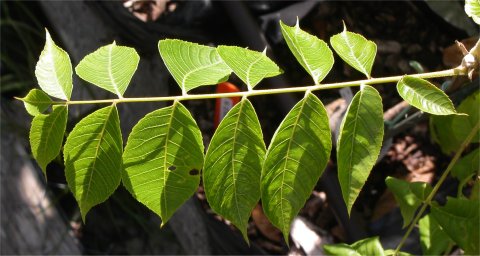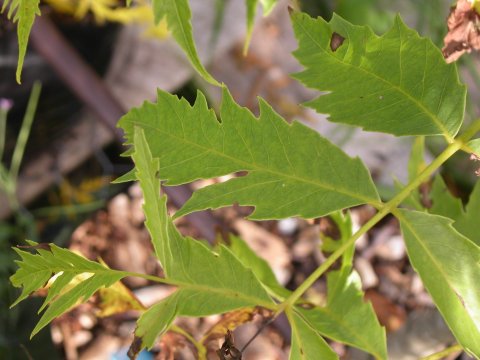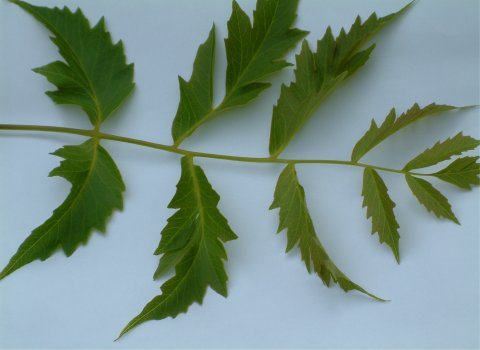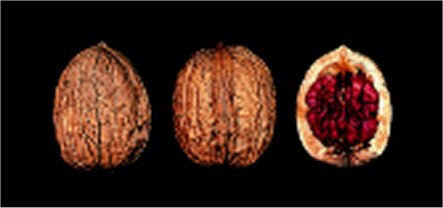Ornamental walnut trees
There are numerous varieties of Juglans regia which are grown mainly for their appearance.
They are mostly tall trees with a very attractive spread of large-leafed foliage. Hansen and Red Danube are also excellent for nut production
Abbotbad
A very fast-growing and large tree, only occasional specimens are available and little is known about its habits.
Bixbyi
An interesting hybrid of Cinerea and the Japanese Walnut (J Ailantifolia) with more characterisitcs of the former, J x Bixbyi makes a stately tree and is a vigorous grower like most hybrid Walnuts.
Cathayensis
The Chinese walnut. Makes a large, powerful tree with leaves up to 80cm in length. Bears nuts in clusters of 6 to 8 and carries interesting catkins of 20-30cm in length.
ORIGIN: China
TREE HABIT AND VIGOUR: Large and stately
NUT TYPE: Small nuts in custers
KERNEL TO NUT RATIO:
LEAFING ONSET:
TYPE OF FLOWERING:
CROPPING: Medium
AGE AT FIRST BEARING: 4/5 years
Cinerea
Also known as the Butternut or the White Walnut, J Cinerea comes from the US but is in serious trouble there from a disease known as Butternut Canker (Sirococcus clavigignenti-juglandacearum. This is not a native disease in the US and was first observed in Iowa in 1967, though it’s believed to have spread from the southeastern coastal region. The age of the oldest cankers found suggests that it first appeared there around 40-50 years ago.
Although there are research efforts trying to find resistant specimens and to find a control for the disease, it may be too late to save the species in North America. Even as far back as 1995, the Forest Service estimated that 77 percent of Cinerea trees in the Southeast were dead. Indeed new grafted plants on J Regia roots are going back there from the UK and Europe in a reversal of the trade in vines after the 19th century phylloxera epidemic, but it is much too early to know whether these trees will demonstrate useful resistance.
As a tree, Cinerea is valued for its sheer size and its hardiness and the timber was much used in carving and furniture. It was common for Cinerea to planted on farmsteads, close to the house. Nut kernels were used in baking, and the husk was often used to dye fabrics. In the American Civil War, Confederate uniforms were dyed using butternut husks.
Emma K
One of the varieties of Black Walnut (Juglans Nigra) which have been developed for thinner shells and fuller kernels, Emma K is grown in the UK more for its decorative leaf and general looks than for nuts. Like all varieties of J. Nigra, the husks do not split when the kernels ripen and must be tested by pressing to see when they begin to soften.
If the husks are left in place after this the nuts may well spoil. Also in common with its sister varieties, the kernel is four-lobed and difficult to free cleanly from the shell, so that the main uses are for baking, topping ice-cream and wherever broken pieces are acceptable.

Hansen
Unusual in that the variety bears nuts in clusters of up to 13 nuts.
Heavy cropper, able to stand very cold winters, thus popular in Canada and the northern US.
ORIGIN: Germany
TREE HABIT AND VIGOUR: Medium, modest grower
NUT TYPE: Small and round
KERNEL TO NUT RATIO: 45-50%
LEAFING ONSET: 1st May
TYPE OF FLOWERING: Protandrous
CROPPING: Medium-Heavy
AGE AT FIRST BEARING: 3-4 years
Intermedia
The interesting offspring of the two commonest walnuts, J.Nigra and J.Regia, the American Black Walnut and the English Walnut.
As the name suggests the tree is an intermediate form between the two species. It bears only incidentally but is noteworthy for its attractive leaves and enormous vigour.
It is late leafing and grows rapidly through a short season from June to November. In suitable conditions Internedia can grow at twice the rate of the English Walnut. Has a tiny pink flower.
Laciniata
The cut-leafed form of the English walnut. Usually makes a small or medium-sized tree characterised by its fine, leathery-looking foliage.
Leaflets are more numerous, thin and deeply incised compared to the typical English walnut.
A decorative but non-fruitful type which is rare in private gardens and only occasionally found in arboreta and collections.


Leopold
J. regia Leopold has characteristically serrated leaves, similar in type to Laciniata.
Microcarpa
The Texan or shrubby walnut. May grow quite fast but reaches a maximum height of little more than 6 or 7 metres.
Delicate leaves made up of 23 leaflets – 11 opposed pairs plus the terminal leaflet.
Major
Known as the Arizona (Black) Walnut or the Nogal. This is the only Walnut species growing in desert conditions. It may reach 20m at the rate of about 30cm per year.
ORIGIN: Texas/Arizona
TREE HABIT AND VIGOUR: Medium for a Black Walnut. Wide crown.
NUT TYPE: Medium and round, with a thick, hard shell.
KERNEL TO NUT RATIO: 40-50% (estimated)
LEAFING ONSET: Not known
TYPE OF FLOWERING: Protandrous
CROPPING: Medium
AGE AT FIRST BEARING: 4-5 years
Paradox
Paradox is an F1 (1st Generation) hybrid of the Northern California black walnut, or Juglans hindsii, crossed with Juglans regia.
Much more vigrous than either of its parents, growing much larger and faster, it does not however produce fruit, and therefore has no significant amounts of pollen. Suited to heavy, wet and poor soils but very susceptible to frost damage and not often available.
ORIGIN: USA
TREE HABIT AND VIGOUR: Medium size and vigour
NUT TYPE: Large and elongate
KERNEL TO NUT RATIO: 60%
LEAFING ONSET: 26th April
TYPE OF FLOWERING: Protandrous
CROPPING: Medium
AGE AT FIRST BEARING: 4 years
Pedro
A small-leafed, self-fertile variety very susceptible to blight. There is not much information as yet on its performance in UK conditions. In California it is one of the varieties trained in the French fashion in cordons.
TREE HABIT AND VIGOUR: Compact, spreading but slow growing
NUT TYPE: Medium-Large
KERNEL TO NUT RATIO:
LEAFING ONSET: Early May
TYPE OF FLOWERING: Slight protandry
CROPPING: Medium
AGE AT FIRST BEARING: 4-5 years
Pendula
An interesting ‘weeping’ variety of J. regia, though little is known of its growth and habits in the UK climate.
TREE HABIT AND VIGOUR: Medium size, pendant branches
Purpurea
Another small, slow-growing form of English walnut. Characterised by leaves which show as a dullish purply-red.
Due to its relatively recent discovery (1938) the plant is comparitively rare – even more so than J. regia laciniata, and is only occasionally available.
Red Danube
Due to its rarity, the characteristics of this variety – also known as ‘Roter Donau’ – have yet to be firmly established when grown under British conditions. Carries an extraordinary red nut, the walnut equivalent of a blood orange.

ORIGIN: Germany/Austria
TREE HABIT AND VIGOUR: Medium size and vigour
NUT TYPE: Medium
KERNEL TO NUT RATIO: 45%
Sinensis
Another uncommon variety from the Far East, few have been grown in the UK as yet so little is known of its habits here. Thought to be a strong grower and heavy bearer.
ORIGIN: Japan/Korea
TREE HABIT AND VIGOUR: Large, vigorous (apparently)
CROPPING: Probably heavy
Ssang Sung
An even more recent arrival from China than Lu Guang and Zhong Lin. It appears to share with Lu Guang poor, papery shell formation and is unlikely to produce good eating nuts.
Tremlett’s giant
As the name suggests, this is a variety which grows into a very large tree. Little is known yet of its bearing characteristics but it seems happy in the UK climate.
Zhong Lin
Like Lu Guang, a recent import from China expected to have the usual characteristics of strong growth and good cropping.